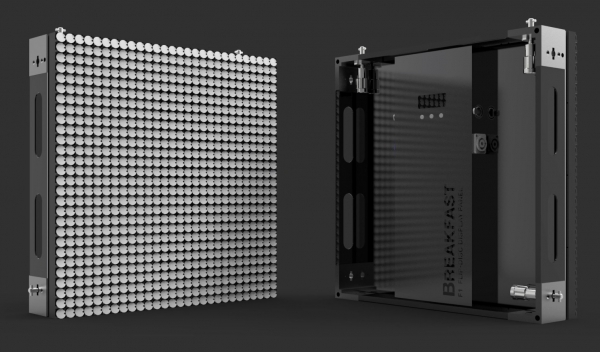How do you make a DLP system work without optics? Easy, just make the pixels big enough. That is exactly what Breakfast, a Brooklyn, NY based company has done. Breakfast is a small company that can be best described as a rapid prototyping company or as a physical digital agency based on their own description.
The idea of mechanical switching pixels is not new by any means. There were many installations around the world that have made way for LED or LCD walls. The issue with mechanical actuators is that they stop working after a while and every sticking actuator means one pixel lost in the display. Repairs are possible, but cumbersome and expensive. In addition these types of displays are typically monochrome compared to full color LED or LCD systems.
Breakfast has been working on this since 2012 and calls its display a ‘Flip Disc Display’, very accurately describing the functionality of their display system. The ‘pixels’ are quite large with a size of 14 x 14mm. This means a FHD display would measure 26.9m (88′) wide and 15m (49′) high. We will have to live with low resolution images it seems. As a reflective display the pixel is monochrome for example white or black, however other combinations like black/yellow, black/red, etc. are also available.
Source: Breakfasting.com – Flip Disc Display
The discs are actuated via magnets and can switch up to 30 times per second. This is enough to show moving images on the display.
The display pixels are combined in panels that each have 28 x 28 pixels and weighing in at 7kg (16 lbs). Combining these panels is easy with the included interlock system and no engineer or developer is needed for getting the system to run.
 Source: Breakfasting.com – Flip Disc Display
Source: Breakfasting.com – Flip Disc Display
In addition to the display panel it comes with a UNIX based control system and all necessary mounting hardware and cables. In addition they throw in a time of flight camera for free. If you wonder what this is for, I suggest to take a look at their product YouTube video. As you can see, the cameras allows the people in front of the screen to interact with the display, which returns to its original message after the interaction has finished. That’s a very entertaining way of making a digital sign more fun than the typical LED or LCD wall. Of course those systems could implement some similar interaction capability as well.
Overall this is more than just a digital sign, it is more of a brand statement and will certainly not replace a LED wall in every application. Just a fun way of mixing things up. For more information and pricing you will have to contact the company directly. – NH

